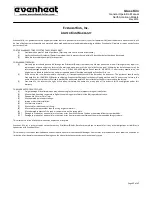
Glass Kiln
General Operation Manual
North American Models
May 2015
Page
10
of
17
Positioning of the Shelf and Glass
Always use a shelf when firing, even when firing with a mold. If problems arise it is much easier and cheaper to replace a shelf than a kiln bottom.
Posts are used to bring the shelf up from the floor of the kiln. This allows the work to be moved closer to the lid elements while allowing heat to reach the
underside of the shelf. A post length of 2” to 3” is typical. Use enough posts to support the shelf securely, 4 being the minimum.
Set the shelf on the posts positioning equally from all sides of the chamber. Set the mold on the shelf if one is being used. Position the glass on the shelf or
mold as desired. You may find that using an adhesive to keep the glass in place helps. This is available from your supplier. Once the glass is positioned
you’re ready to fire.
Firing Procedure
General Firing Procedure
It’s not possible to layout an exact firing schedule for all glass. Much depends on the type of hot glass work that is being done, the type of glass that’s
being used and the effects desired. The following procedure is a very basic fusing schedule. It’s designed primarily to teach you about the various control
functions and what is done throughout a firing.
Generally speaking, glass can be taken to 1000°F in the first hour of firing. This rate allows the temperature of the glass to increase relatively quickly
without breakage. After the 1000°F temperature has been reached the glass can be fired as fast as possible to the fusing temperatures or until desired
results are achieved. Fusing temperatures range from 1300 to 1500°F. Once desired results are achieved the kiln is vented quickly to stop further changes
to the glass. After this venting period the kiln is closed and allowed to cool slowly which anneals the glass.
Firing Procedure for Automatic Controls
Once glass is loaded prop the lid open ½ to 1” with a post or firebrick and open the peephole. This allows fumes from adhesives and organic materials to
escape. Gold, silver, decals, paints release fumes while firing and will leave an unwanted finish on the glass. If you’re not firing any items such as these you
may skip this step.
Program your automatic control with the firing information. A separate programming manual has been included for your control. Read it thoroughly and
become familiar with it before attempting to fire. It’s wise to develop your firing plans before attempting to program.
Start the firing.
If the lid was propped open, close the lid once 1000°F has been reached.
Check the firing periodically. Continue to fire until desired results are achieved.
Once the desired results are achieved vent the kiln to stop further changes to the glass. Check the automatic control to see that it is either off or following
your actions. It may be necessary to reprogram or skip ahead in the program to reach this point. Venting can be accomplished in many ways. You may prop
the lid open with a post or firebrick or you may open and close the lid slightly for a number of times. The point here is to stop further changes to the glass.
Choose a technique you feel comfortable with. It must be mentioned that protective clothing, gloves and eyewear be worn when handling a hot kiln. This
is important at any stage of the firing.
Continue venting until the temperature falls to about 1100°F or so. When the chamber reaches this temperature, close the lid completely. The
temperature of the firing chamber tends to rise a bit once the lid is closed. This is normal and will generally not harm or change the glass.
The glass must now be allowed to anneal. Annealing is the process of reducing internal stresses in the glass. Your glass will have an annealing temperature,
however, it’s often unknown and often not given by the manufacturer. In this case we perform what we call a “shotgun anneal”: allowing the temperature
of the kiln to cool slowly over a period of time. In this way it’s assumed that the anneal temperature will be within the slow cooling range. Typically, this
slow cooling takes place between 1100°F and 600°F. How slow is slow? Thinner glass anneals faster than thicker glass. General rates may be between 60 to
100°F per hour. When in doubt, go slow. You can’t over anneal glass.
Once the temperature of the kiln is below your annealing range allow the kiln to cool to room temperature. Once cooled to room temperature it’s safe to
remove the glass from the kiln.



































